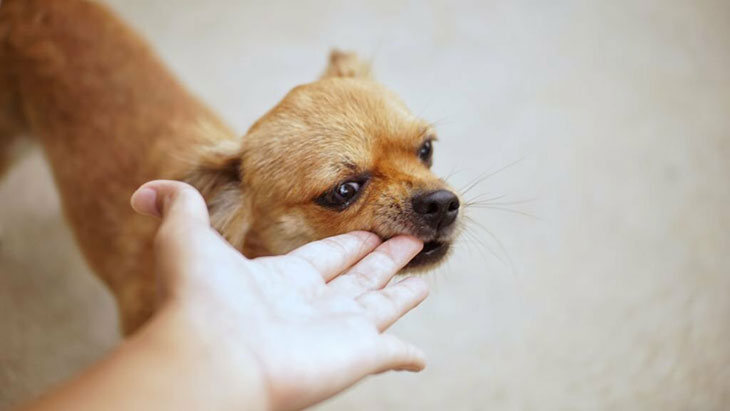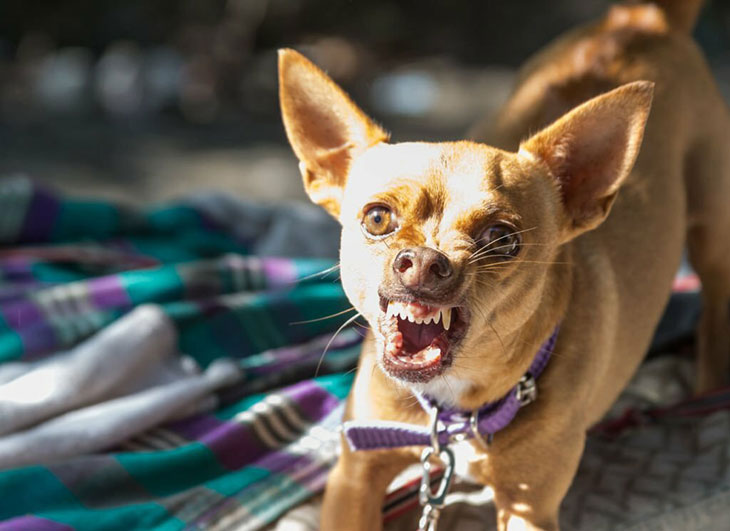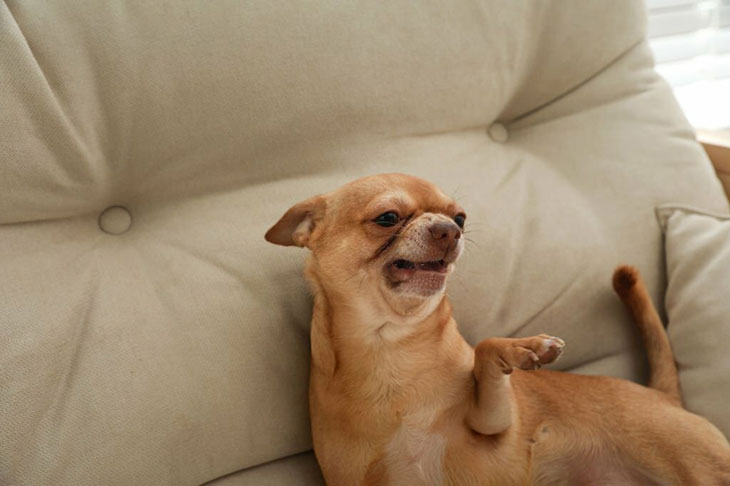Unlike some other dog breeds, chihuahuas are friendly and social, so many love having them around.
However, this confidence might sometimes lead to their aggressive behaviors around other dogs or even their owners! What to do, then?
Based on my experience, I will suggest some tips on how to train a chihuahua not to be aggressive. Scroll to learn more.
Why Is My Chihuahua So Aggressive?

Stress
When stressed, Chihuahuas often avert their faces, breathe faster, lick their mounts, yawn, and show other symptoms before they become fully aggressive.
Unfortunately, many Chihuahua owners take these signs for granted and even find them funny. No wonder the behaviors escalate to aggressive snarling and, worse, biting!
No Training
Several studies have pointed out that people usually seek professional training for larger dogs (e.g., Pit bulls) rather than smaller ones like Chihuahuas, believing that the latter is unlikely to cause serious damage.
Due to this popular assumption, little dogs like Chihuahuas cannot control their stress, anxiety, insecurity, and even fear.
They naturally become more aggressive to shield themselves against external threats, leading to bad behaviors that only professionals can handle.
Little Socialization
Lack of socialization is another common factor.
If your Chihuahua is rarely exposed to varied situations and people, he will get defensive and suspicious of any new circumstance, sound, or sight.
Anything will be considered a threat to him, hence the aggressive reactions. That’s why these Chihuahua pups tend to fight with each other more often.
Lack of Exercise
Do you often get your Chihuahua to exercise? Sure, they are widely recognized as lap dogs (those that prefer to stay by their owners 24/7), but that does not give you an excuse to let them lie at home all day.
Like any other breed, Chihuahuas need lots of mental and physical stimulation to stay happy, well-behaved, and healthy.
Without enough exercise, they will get more hyperactive, barking and wagging their tails constantly to let out their pent-up energy and frustration.
Medical Conditions
If none of the abovementioned possibilities apply to your case, then health-related problems are quite likely.
Chihuahua aggression might result from physical discomfort (unsurprising, given their very delicate bones), underlying hypothyroidism, or dental issues.
Even neurological problems like brain tumors or epilepsy should be considered as well.
Since most dog owners usually do not have much knowledge or expertise regarding these issues, the best solution is to visit a vet to identify the root causes and give your dog some appropriate treatment.
Protecting Their Territory
These Chihuahuas are still guard dogs at the end of the day.
This means they can be very territorial and easily get defensive by strangers or unfamiliar faces that intrude on their personal space.
Specifically, they have already marked that area as “theirs” and only let you (or any other person it feels comfortable with) enter it.
How to Train A Chihuahua Not To Be Aggressive

To train your Chihuahua to be less aggressive, establish clear house rules and teach him how to control his bite, preferably from an early age.
Reward him when he does well, but avoid harsh punishments whenever he growls or snaps.
You should also expose him frequently to other dogs, larger animals, and people.
Reward Its Good Behaviors
Can you train a Chihuahua to be friendly? Yes.
Whenever your Chihuahua listens to you and stops snapping and growling, remember to praise him and reward these behaviors with good treats.
Likewise, once he starts becoming aggressive, act firmly to make him stop. You do not have to be too strict on him, of course, but always make sure the message gets through.
Consistent Aggressive Chihuahua Training
Teaching the dogs basic cues and commands is important. A few examples include:
- Commands: sitting, staying, and coming. They can stop your dog from threatening or attacking any stranger.
- Walking on the leash: this training practice will establish you (the owner) as the ultimate alpha. Your Chi will learn how to react to your commands more appropriately.
I understand this might be very hard for extremely aggressive Chihuahua (as they often see themselves as alphas and do not listen to others that easily).
But no worries; consistent effort will help you succeed. And even if the dog has already taken part in obedience training, a few daily recall sessions will still be useful.
Training techniques for dogs and chihuahuas have numerous variations, but the three following methods are the most popular:
a. Alternate Behavior Training
Step 1. Choose an empty and quiet space (without distractions) to teach him basic commands like “down-stay” or “sit-stay.” Give him a treat whenever he obeys.
Step 2. Keep practicing “down-stay” and “sit-stay” in various environments (and with different types of distractions) until your dog is familiar with them.
Step 3. Keep practicing the above commands. But this time, change the rewards and treats to something else.
Step 4. Whenever he starts to snap, growl, and pose aggressively, distract him while giving him the “down-stay” or “sit-stay” command.
Step 5. Do not forget to praise him when he complies; it will help distract him from vicious and aggressive tendencies.
b. Extinguish Aggression
Step 1. Change the circumstances. For instance, if he often acts aggressively toward other people when sprawling in your lap, do not let him sit in your lap anymore when others are around.
Step 2. Distract his severe aggression with noise makers or by saying “No” firmly. And when he calms down, praise him and reinforce his obedience with a good treat.
Step 3. Gradually increase your expectations before giving him rewards, treats, or attention.
For instance, during the first week, give him a good meal if he acts calm and friendly for 30 minutes at a time. The next week, increase the interval to 45 minutes or 1 hour.
c. Establish Leadership
Step 1. Teach him to obey basic commands like “stay,” “sit,” “heel,” “come,” and “down.”
Step 2. Make it clear to him that you are his food provider; he must wait until you prepare and bring the food to him. And while he is eating, sit next to him to establish your position as a provider.
You may remove and return the food constantly to set expectations for him.
Step 3. Introduce him to other animals, dogs, and people in a non-threatening and friendly environment.
Reinforce all the good interactions with rewards and treats; and if the dog starts to act aggressively, remove him from the situation while you keep interacting with others.
Also, always keep him at ground level; never pick him up or on the same eye level as others or yourself.
Build The Rules
How to tame an aggressive Chihuahua?
Like other aggressive dogs (e.g., Boerboel), Chihuahuas also need strict structure to function properly, which explains why house rules are important.
Avoid letting your dog dominate since this habit will gradually develop into irreversible aggression; the key to success is to stick with your firm decision no matter what.
Refer to your own preferences to decide the rules regarding the following:
- What food should you give to your dogs?
- What furniture can he sit on?
- What items belong to him?
- When is his playtime?
Again, stay consistent and firm with the aforementioned rules without being too harsh on him.
You can also use positive reinforcements to help him learn and respect all these boundaries.
Let Him Socialize
As briefly mentioned above, Chihuahuas tend to become much more defensive if not socialized enough.
The reason is simple: since he is not exposed to other environments, animals, and people, the fear of the unknown will trigger him, causing him to attack anything he considers a threat.
Studies by researchers at Tuft Uni also confirmed that unsocialized puppies suffer from aggression risks 580 times higher than other dogs in the latter half of their lives.
Hence, to ensure his controlled behaviors and healthier life, you should try your best to show your canine friend that not all animals and people are bad.
And it would be even better if you start doing so while he is still a little puppy!
Puppies between 3 and 16 weeks old are the most sensitive to all types of socialization – making it a critical period to control aggression.
When your Chi has a good impression of other animals and people from an early age, he will definitely develop a more comfortable, relaxed disposition to strangers and unfamiliar faces as he grows up.
Some tips on how to calm an aggressive Chihuahua when socializing:
- Ensure he gets the latest vaccinations before being exposed to other animals and people
- Bring him to a local pet store or on your car trips (remember not to leave him inside the car when you get off, though)
- Walk with him on wooded trails, through the neighborhood, or to dog parks. When arriving at the dog park, walk your Chi outside the fence first.
- Play fetch outdoors with him.
- Take him to your family members’ or friends’ homes. You can also invite your acquaintances to your house and encourage them to interact with the dog.
- Enroll him in a proper training class or Chihuahua school.
- Reward him with good treats after every socialization experience.
Avoid Punishments When He Growls
Many dog owners usually scold and punish their dogs for growling.
That seems like a good method, but it is not; in fact, it eliminates the key warning signal that precedes the bites, meaning your dog will bite immediately without warning when provoked next time!
So does that mean you must let him growl without punishment? While that might sound counterproductive, many experiments have proven that it works.
Not to mention, the growls can reveal a lot about the common reasons behind his aggressive behaviors; for instance:
- If he growls when you pick him up, chances are there is a medical condition or painful injury
- If the dog acts defensively when another dog enters his crate, he is trying to protect his territory
Teach Him to Control His Bite
The goal here is not to keep him from biting you or others – but to help him manage the force and strength of each bite.
Most puppies learn this at an early age while playing with their siblings or nursing; for instance, when he bites his littermate too hard, the other dog will yelp out loud (as a way of saying, “You bit too hard!”).
The same applies to nursing; the mother will get off the ground or walk away if her puppies bite her too hard.
Hence, to keep being around his littermates and mothers, the dog has no other choice but to learn to adjust his bite.
That also explains why you should let the Chihuahua pup stay with its mother for 8-10 weeks.
When removed too soon, he cannot develop strong bite control through nursing or playing. Keep this tip in mind for singletons (born with no playmates) as well.
Three important rules you must comply with when teaching the Chi to control his bites:
- Respond to aggressive bites. You can pull your fingers away or say, “That hurts!”. Ignore the Chi for 5-10 minutes to discourage him from repeating the behavior.
- Train him consistently. Consistency is always the key to any successful training. If you yell “Ouch!’ when he bites you for the first time but not the second time, the mixed messages will confuse him.
- Reinforce his behaviors into adulthood. Bite inhibition must indeed be taught early, but that does not mean you should stop reinforcing it over time until the pup has grown up.
Spaying and Neutering
Spaying eliminates heat cycles and hormone-driven behaviors for female Chihuahuas – and, as a result, reduces the Chihuahua biting aggression.
Meanwhile, neutering lowers testosterone levels to control urinating, aggression, running away, separation anxiety, and hyperactivity.
Studies also reveal that 60% of male Chihuahuas show fewer intermale aggression symptoms after neutering (25% experience rapid reduction, 35% gradual).
Seek Help from Professional Dog Trainers
None of the above works for your Chihuahua?
Do not just give up; seek professional advice or consult with an expert to investigate its behaviors and try out more effective training methods.
How Long Does It Take for The Results to Show Up?

There is no fixed number since the symptoms of canine aggression vary a lot. Some Chihuahuas only take several days, while others might take longer.
Still, if your dog does not improve much after 2-3 weeks, professional 1-on-1 training with licensed behavioral experts is a must.
Conclusion
My guide has listed several key suggestions and tips on how to train a Chihuahua not to be aggressive.
Serious cases might take weeks or months (or even specialized help), but be patient; as long as you use the training methods properly, your dog will definitely control itself better over time.
